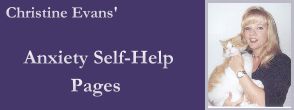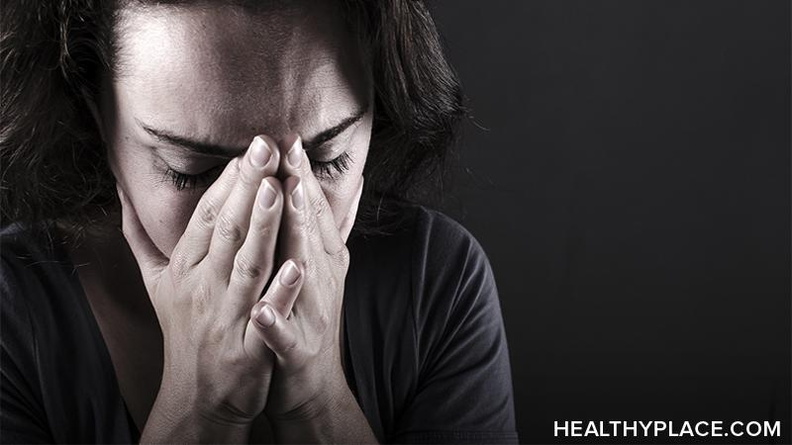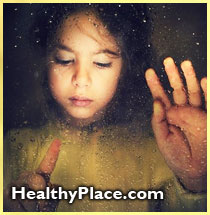
Susan M. Lark, M.D.
(Excerpted from The Menopause Self Help Book Celestial Arts, Berkeley)
Women with increased levels of anxiety and nervous tension often need to develop more effective ways of dealing with day to day stresses the minor everyday pressures that women with a healthy emotional balance handle easily but that can be overwhelming for women whose anxiety responses are easily triggered. Such stress can include riding in an elevator, being in crowds, going to the dentist, or any situation, place, or person that sparks a woman's emotional charge.
Often these charged issues evoke anxiety, fear, or upset feelings. Moreover, significant lifestyle changes death of a loved one, divorce, job loss, financial problems, major changes in personal relationships can be almost impossible to handle when a woman is already feeling anxious and tense. Being unable to cope with stress effectively can also damage a woman's self esteem and self confidence. A woman with anxiety episodes may feel a decreasing sense of self-worth as her ability to handle her usual range of activities diminishes. Life stresses themselves don't necessarily change, so how a woman copes with them can really make the difference.
How Stress Affects the Body
Your emotional and physical reactions to stress are partly determined by the sensitivity of your sympathetic nervous system. This system produces the fight or flight reaction in response to stress and excitement, speeding up and heightening the pulse rate, respiration, muscle tension, glandular function, and circulation of the blood.
If you have recurrent anxiety symptoms, either major or minor lifestyle and emotional upsets may cause an overreaction of your sympathetic system. If you have an especially stressful life, your sympathetic nervous system may always be poised to react to a crisis, putting you in a state of constant tension. In this mode, you tend to react to small stresses the same way you would react to real emergencies.
The energy that accumulates in the body to meet this "emergency" must be discharged in order to bring your body back into balance. Repeated episodes of the fight or flight reaction deplete your energy reserves and, if they continue, cause a downward spiral that can lead to emotional burnout and eventually complete exhaustion. You can break this spiral only by learning to manage stress in a way that protects and even increases your energy level.
Techniques for Relaxation
Many patients have asked me about techniques for coping more effectively with stress. Although I send some women for counseling or psychotherapy when symptoms are severe, most are looking for practical ways to manage stress on their own. They want to take responsibility for handling their own problems observing their inadequate methods of dealing with stress, learning new techniques to improve their habits, and then practicing these techniques on a regular basis.
I have included relaxation and stress reduction exercises in many of my patient programs. The feedback has been very positive; many patients report an increased sense of well being from these self-help techniques. They also note an improvement in their physical health. This chapter includes fourteen stress reduction exercises for women with anxiety. They will take you through a series of specific steps to help alleviate your symptoms. The exercises will teach you the following helpful techniques: focusing and meditation, grounding techniques (how to feel more centered), exercises that help you to relax and release muscle tension, erasure techniques (how to erase old programs), healing the inner child, visualizations, and affirmations. These techniques will help you cope with stress more efficiently, make your thoughts more calm and peaceful, and help you learn to relax, while you build self-esteem and self-confidence. Try them all; then decide which ones produce the greatest benefits for you. Practice these on a regular basis.
Quieting the Mind and Body
Women with recurring symptoms of anxiety and nervous tension are usually barraged by a constant stream of negative "self-talk." Throughout the day your conscious mind may be inundated with thoughts, feelings, and fantasies that trigger feelings of upset. Many of these thoughts replay unresolved issues of health, finances, or personal and work relationships. This relentless mental replay of unresolved issues can reinforce the anxiety symptoms and be exhausting. It is important to know how to shut off the constant inner dialogue and quiet the mind.
The first two exercises require you to sit quietly and engage in a simple repetitive activity. By emptying your mind, you give yourself a rest. Meditation allows you to create a state of deep relaxation, which is very healing to the entire body. Metabolism slows, as do physiological functions such as heart rate and blood pressure. Muscle tension decreases. Brain wave patterns shift from the fast beta waves that occur during a normal active day to the slower alpha waves, which appear just before falling asleep or in times of deep relaxation. If you practice these exercises regularly, they can help relieve anxiety by resting your mind and turning off upsetting thoughts.
Exercise 1: Focusing
Select a small personal object that you like a great deal. It might be a jeweled pin or a simple flower from your garden. Focus all your attention on this object as you inhale and exhale slowly and deeply for one to two minutes. While you are doing this exercise, try not to let any other thoughts or feelings enter your mind. If they do, just return your attention to the object. At the end of this exercise you will probably feel more peaceful and calmer. Any tension or nervousness that you were feeling upon starting the exercise should be diminished.
Exercise 2: Meditation
- Sit or lie in a comfortable position.
- Close your eyes and breathe deeply. Let your breathing be slow and relaxed.
- Focus all your attention on your breathing. Notice the movement of your chest and abdomen in and out.
- Block out all other thoughts, feelings, and sensations. If you feel your attention wandering, bring it back to your breathing.
- As you inhale, say the word "peace" to yourself, and as you exhale, say the word "calm." Draw out the pronunciation of the word so that it lasts for the entire breath. The word "peace" sounds like p-e-e-a-a-a-c-c-c-e-e-e. The word "calm" sounds like: c-a-a-a-l-l-l-l-m-m-m. Repeating these words as you breathe will help you to concentrate.
- Continue this exercise until you feel very relaxed.
Grounding Techniques
Many women suffering from anxiety episodes often feel ungrounded and disorganized. There is a pervasive sense of "things falling apart." When anxiety episodes occur, it often takes a concentrated effort just to get through the day, accomplishing such basic daily tasks as cooking, house cleaning, taking care of children, or getting to work or school. The next two exercises teach you grounding techniques that will help you feel more centered and focused. Practicing either of these exercises will allow you to organize your energies and proceed more effectively with your daily routine.
Exercise 3: Oak Tree Meditation
- Sit in a comfortable position, your arms resting at your sides.
- Close your eyes and breathe deeply. Let your breathing be slow and relaxed.
- See your body as a strong oak tree. Your body is solid like the wide, brown trunk of the tree. Imagine sturdy roots growing from your legs and going down deeply into the earth, anchoring your body. You feel solid and strong, able to handle any stress.
- When upsetting thoughts or situations occur, visualize your body remaining grounded like the oak tree. Feel the strength and stability in your arms and legs.
- You feel confident and relaxed, able to handle any situation.
Exercise 4: Grounding Cord Meditation
- Sit in a comfortable position, your arms resting comfortably at your sides.
- Close your eyes and breathe deeply. Let your breathing be slow and relaxed.
- Imagine a thick wide cord attaching itself to the base of your spine. This is your grounding cord. It can be a thick piece of rope, a tree trunk, or any other material that feels strong and stable. Make sure your cord is wide and sturdy enough. Then imagine a thick metal hook attaching itself to the end of your cord.
- Now visualize your grounding cord dropping down two hundred feet below the earth and hooking on to the solid bedrock below the earth.
- Continue to breathe deeply and notice the sense of peace and stability that your grounding cord can bring you.
- Replace the cord with a new one each day or whenever you feel your emotions getting out of control.
Releasing Muscle Tension
The next three exercises will help you get in touch with your areas of muscle tension and then help you learn to release this tension. This is an important sequence for women with emotional symptoms of anxiety and nervous tension since habitual emotional patterns cause certain muscle groups to tense and tighten. For example, if a person has difficulty in expressing feelings, the neck muscles may be chronically tense. A person with a lot of repressed anger may have chest pain and tight chest muscles. Contracted muscles limit movement and energy flow in the body, since they tend to have decreased blood circulation and oxygenation and accumulate an excess of waste products, such as carbon dioxide and lactic acid. Therefore, muscle tension can be a significant cause of the fatigue that often accompanies chronic stress. The following exercises help release tension and the blocked emotions held in tight muscles.
Exercise 5: Discovering Muscle Tension
- Lie on your back in a comfortable position. Allow your arms to rest at your sides, palms down, on the surface next to you.
- Raise just the right hand and arm and hold it elevated for 15 seconds.
- Notice if your forearm feels tight and tense or if the muscles are soft and pliable.
- Let your hand and arm drop down and relax. The arm muscles will relax too.
- As you lie still, notice any other parts of your body that feel tense, muscles that feel tight and sore. You may notice a constant dull aching in certain muscles.
Exercise 6: Progressive Muscle Relaxation
- Lie on your back in a comfortable position. Allow your arms to rest at your sides, palms down, on the surface next to you.
- Inhale and exhale slowly and deeply.
- Clench your hands into fists and hold them tightly for 15 seconds. As you do this, relax the rest of your body. Visualize your fists contracting, becoming tighter and tighter.
- Then let your hands relax. On relaxing, see a golden light flowing into the entire body, making all your muscles soft and pliable.
- Now, tense and relax the following parts of your body in this order: face, shoulders, back, stomach, pelvis, legs, feet, and toes. Hold each part tensed for 15 seconds and then relax your body for 30 seconds before going on to the next part.
- Finish the exercise by shaking your hands and imagining the remaining tension flowing out of your fingertips.
Exercise 7: Release of Muscle Tension and Anxiety
- Lie in a comfortable position. Allow your arms to rest at your sides, palms down. Inhale and exhale slowly and deeply with your eyes closed.
- Become aware of your feet, ankles, and legs. Notice if these parts of your body have any muscle tension or tightness. If so, how does the tense part of your body feel? Is it viselike, knotted, cold, numb? Do you notice any strong feelings, such as hurt, upset, or anger, in that part of your body? Breathe into that part of your body until you feel it relax. Release any anxious feelings with your breathing, continuing until they begin to decrease in intensity and fade.
- Next, move your awareness into your hips, pelvis, and lower back. Note any tension there. Notice any anxious feelings located in that part of your body. Breathe into your hips and pelvis until you feel them relax. Release any negative emotions as you breathe in and out
- Focus on your abdomen and chest. Notice any anxious feelings located in this area and let them drop away as you breathe in and out. Continue to release any upsetting feelings located in your abdomen or chest.
- Finally, focus on your head, neck, arms, and hands. Note any tension in this area and release it. With your breathing; release any negative feelings blocked in this area until you can't feel them anymore.
- When you have finished releasing tension throughout the body, continue deep breathing and relaxing for another minute or two. At the end of this exercise, you should feel lighter and more energized.
Erasing Stress and Tension
Often the situations and beliefs that make us feel anxious and tense look large and insurmountable. We tend to form representations in our mind that empower stress. In these representations, we look tiny and helpless, while the stressors look huge and unsolvable. You can change these mental representations and cut stressors down to size. The next two exercises will help you to gain mastery over stress by learning to shrink it or even erase it with your mind. This places stress in a much more manageable and realistic perspective. These two exercises will also help engender a sense of power and mastery, thereby reducing anxiety and restoring a sense of calm.
Exercise 8: Shrinking Stress
- Sit or lie in a comfortable position. Breathe slowly and deeply.
- Visualize a situation, person, or even a belief (such as, "I'm afraid of the dark" or "I don't want to give that public speech") that makes you feel anxious and tense.
- As you do this, you might see a person's face, a place you're afraid to go, or simply a dark cloud. Where do you see this stressful picture? Is it above you, to one side, or in front of you? How does it look? Is it big or little, dark or light? Does it have certain colors?
- Now slowly begin to shrink the stressful picture. Continue to see the stressful picture shrinking until it is so small that it can literally be held in the palm of your hand. Hold your hand out in front of you, and place the picture in the palm of your hand.
- If the stressor has a characteristic sound (like a voice or traffic noise), hear it getting tiny and soft. As it continues to shrink, its voice or sounds become almost inaudible.
- Now the stressful picture is so small it can fit on your second finger. Watch it shrink from there until it finally turns into a little dot and disappears.
- Often this exercise causes feelings of amusement, as well as relaxation, as the feared stressor shrinks, gets less intimidating, and finally disappears.
Exercise 9: Erasing Stress
- Sit or lie in a comfortable position. Breathe slowly and deeply.
- Visualize a situation, a person, or even a belief (such as, "I'm afraid to go to the shopping mall" or "I'm scared to mix with other people at parties") that causes you to feel anxious and fearful.
- As you do this you might see a specific person, an actual place, or simply shapes and colors. Where do you see this stressful picture? Is it below you, to the side, in front of you? How does it look? Is it big or little, dark or light, or does it have a specific color?
- Imagine that a large eraser, like the kind used to erase chalk marks, has just floated into your hand. Actually feel and see the eraser in your hand. Take the eraser and begin to rub it over the area where the stressful picture is located. As the eraser rubs out the stressful picture it fades, shrinks, and finally disappears. When you can no longer see the stressful picture, simply continue to focus on your deep breathing for another minute, inhaling and exhaling slowly and deeply.
Healing the Inner Child
Many of our anxieties and fears come from our inner child rather than our adult self. Sometimes it is difficult to realize that the emotional upsets we feel are actually feelings left over from childhood fears, traumas, and experiences. When unhealed, they remain with us into adulthood, causing emotional distress over issues that competent "grown up" people feel they should be able to handle. For example, fear of the dark, fear of being unlovable, and fear of rejection often originate in early dysfunctional or unhappy experiences with our parents and siblings. While many of these deep, unresolved emotional issues may require counseling, particularly if they are causing anxiety episodes, there is much that we can do for ourselves to heal childhood wounds. The next exercise helps you to get in touch with your own inner child and facilitates the healing process.
Exercise 10: Healing the Inner Child
- Sit or lie in a comfortable position. Breathe slowly and deeply.
- Begin to get in touch with where your inner child resides. Is she located in your abdomen, in your chest, or by your side? (This may actually be the part of your body where you feel the most fear and anxiety, such as your chest or your pelvis.) How old is she? Can you see what clothes she is wearing? What are her emotions? Is she upset, anxious, sad, or angry? Is she withdrawn and quiet?
- Begin to see her upset feelings flow out of her body and into a container on the floor. Watch the upset feelings wash out of every part of her body until they are all gone and the container is full. Then seal the container and slowly watch it fade and dissolve until it disappears completely, carrying all the upset feelings with it.
- Now begin to fill your inner child with a peaceful, healing, golden light. Watch her become peaceful and mellow as the light fills every cell in her body. Watch her body relax. Give her a toy animal or a doll or even cuddle her in your arms.
- As you leave your inner child feeling peaceful, return your focus to your breathing. Spend a minute inhaling and exhaling deeply and slowly. If you like working with your inner child, return to visit her often!
Visualization
The next two exercises use visualization as a therapeutic method to affect the physical and mental processes of the body; both focus on color. Color therapy, as it applies to human health, has a long and distinguished history. In many studies, scientists have exposed subjects to specific colors, either directly through exposure to light therapy, or through changing the color of their environment. Scientific research throughout the world has shown that color therapy can have a profound effect on health and well-being. It can stimulate the endocrine glands, the immune system, and the nervous system, and help to balance the emotions. Visualizing color in a specific part of the body can have a powerful therapeutic effect, too, and can be a good stress management technique for relief of anxiety and nervous tension.
The first exercise uses the color blue, which provides a calming and relaxing effect. For women with anxiety who are carrying a lot of physical and emotional tension, blue lessens the fight or flight response. Blue also calms such physiological functions as pulse rate, breathing, and perspiration, and relaxes the mood. If you experience chronic fatigue and are tense, anxious, or irritable, or carry a lot of muscle tension, the first exercise will be very helpful.
The second exercise uses the color red, which can benefit women who have fatigue due to chronic anxiety and upset. Red stimulates all the endocrine glands, including the pituitary and adrenal glands. It heightens senses such as smell and taste. Emotionally, red is linked to vitality and high energy states. Even though the color red can speed up autonomic nervous system function, women with anxiety-related fatigue can benefit from visualizing this color. I often do the red visualization when I am tired and need a pick me up. You may find that you are attracted to the color in one exercise more than another. Use the exercise with the color that appeals to you the most.
Exercise 11: Tension Release Through Color
- Sit or lie in a comfortable position, your arms resting at your sides. As you take a deep breath, visualize that the earth below you is filled with the color blue. This blue color extends 50 feet below you into the earth. Now imagine that you are opening up energy centers on the bottom of your feet. As you inhale, visualize the soft blue color filling up your feet. When your feet are completely filled with the color blue, then bring the color up through your ankles, legs, pelvis, and lower back.
- Each time you exhale, see the blue color leaving through your lungs, carrying any tension and stress with it. See the tension dissolve into the air.
- Continue to inhale blue into your abdomen, chest, shoulders, arms, neck, and head. Exhale the blue slowly out of your lungs. Repeat this entire process five times and then relax for a few minutes.
Exercise 12: Energizing Through Color
- Sit or lie in a comfortable position, your arms resting easily at your sides. As you take a deep breath, visualize a big balloon above your head filled with a bright red healing energy. Imagine that you pop this balloon so all the bright red energy is released.
- As you inhale, see the bright red color filling up your head. It fills up your brain, your face, and the bones of your skull. Let the bright red color pour in until your head is ready to overflow with color. Then let the red color flow into your neck, shoulders, arms, and chest. As you exhale, breathe the red color out of your lungs, taking any tiredness and fatigue with it. Breathe any feeling of fatigue out of your body.
- As you inhale, continue to bring the bright, energizing red color into your abdomen, pelvis, lower back, legs, and feet until your whole body is filled with red. Exhale the red color out of your lungs, continuing to release any feeling of fatigue. Repeat this process five times. At the end of this exercise, you should feel more energized and vibrant. Your mental energy should feel more vitalized and clear.
Affirmations
The following two exercises give you healthful affirmations that are very useful for women with anxiety. As described earlier, anxiety symptoms are due to a complex interplay between the mind and body. Your state of emotional and physical health is determined in part by the thousands of mental messages you send yourself each day with your thoughts. For example, if fear of public places triggers your anxiety symptoms, the mind will send a constant stream of messages to you reinforcing your beliefs about the dangers and mishaps that can occur in public places. The fright triggers muscle tension and shallow breathing. Similarly, if you constantly criticize the way you look, your lack of self-love may be reflected in your body. For example, your shoulders will slump and you may have a dull and lackluster countenance.
Affirmations provide a method to change these negative belief systems to thoughts that preserve peace and calm. Positive statements replace the anxiety inducing messages with thoughts that make you feel good.
The first affirmation exercise gives you a series of statements to promote a sense of emotional and physical health and well being. Using these affirmations may create a feeling of emotional peace by changing your negative beliefs about your body and health into positive beliefs. The second affirmation exercise helps promote self-esteem and self-confidence and also helps to reduce anxiety. Many women with high anxiety lose their self-confidence and feel depressed and defeated by their condition. They feel frustrated and somehow at fault for not finding a solution. Repeat each affirmation to yourself or say them out loud 3 to 5 minutes. Use either or both exercises on a regular basis to promote healthful, positive thought patterns.
Exercise 13: Positive Mind/Body Affirmations
- I handle stress and tension appropriately and effectively.
- My mood is calm and relaxed.
- I can cope well and get on with my life during times of stress.
- I think thoughts that uplift and nurture me.
- I enjoy thinking positive thoughts that make me feel good about myself and my life.
- I deserve to feel good right now.
- I feel peaceful and calm.
- My breathing is slow and calm.
- My muscles are relaxed and comfortable.
- I feel grounded and fully present.
- I can effectively handle any situation that comes my way.
- I think through the solutions to my emotional issues slowly and peacefully.
- I am thankful for all the positive things in my life.
- I practice the relaxation methods that I enjoy.
- My body is healthy and strong.
- I eat a well balanced and nutritious diet.
- I enjoy eating delicious and healthful food.
- My body wants food that is easy to digest and high in vitamins and minerals.
- I do regular exercise in a relaxed and enjoyable manner.
Exercise 14: Self-Esteem Affirmations
- I am filled with energy, vitality, and self-confidence.
- I am pleased with how I handle my emotional needs.
- I know exactly how to manage my daily schedule to promote my emotional and physical well-being.
- I listen to my body's needs and regulate my activity level to take care of those needs.
- I love and honor my body.
- I fill my mind with positive and self-nourishing thoughts.
- I am a wonderful and worthy person.
- I deserve health, vitality, and peace of mind.
- I have total confidence in my ability to heal myself.
- I feel radiant with abundant energy and vitality.
- The world around me is full of radiant beauty and abundance.
- I am attracted only to those people and situations that support and nurture me.
- I appreciate the positive people and situations that are currently in my life.
- I love and honor myself.
- I enjoy my positive thoughts and feelings.
More Stress-Reduction Techniques for Anxiety
The rest of this chapter contains additional techniques useful for relief of anxiety and relaxation of tight and tense muscles. These methods induce deep emotional relaxation. Try them for a delightful experience.
Hydrotherapy
For centuries, people have used warm water as a way to calm moods and relax muscles. You can have your own "spa" at home by adding relaxing ingredients to the bath water. I have found the following formula to be extremely useful in relieving muscle pain and tension.
Alkaline Bath
Run a tub of warm water. Heat will increase your menstrual flow, so keep the water a little cooler if heavy flow is a problem. Add one cup of sea salt and one cup of bicarbonate of soda to the tub. This is a highly alkaline mixture and I recommend using it only once or twice a month. I've found it very helpful in reducing cramps and calming anxiety and irritability. Soak for 20 minutes. You will probably feel very relaxed and sleepy after this bath; use it at night before going to sleep. You will probably wake up feeling refreshed and energized the following day. Heat of any kind helps to release muscle tension. Many women find that saunas and baths also help to calm their moods.
Sound
Music can have a tremendously relaxing effect on our minds and bodies. For women with anxiety and nervous tension, I recommend slow, quiet music classical music is particularly good. This type of music can have a pronounced beneficial effect on your physiological functions. It can slow your pulse and heart rate, lower your blood pressure, and decrease your levels of stress hormones. It promotes peace and relaxation and helps to induce sleep. Nature sounds, such as ocean waves and rainfall, can also induce a sense of peace and relaxation. I have patients who keep tapes of nature sounds in their cars and at home for use when they feel more stressed. Play relaxing music often when you are aware of increased emotional and physical tension.
Massage
Massage can be extremely therapeutic for women who feel anxious. Gentle touching either by a trained massage therapist, your relationship partner, or even yourself can be very relaxing. Tension usually fades away relatively quickly with gentle, relaxed touching. The kneading and stroking movement of a good massage relaxes tight muscles and improves circulation. If you can afford to do so, I recommend treating yourself to a professional massage during times of stress. Otherwise, trade with a friend or partner. There are also many books available that instruct people how to massage themselves.
Putting Your Stress-Reduction Program Together
This chapter has introduced you to many different ways to reduce anxiety and stress and make each day calm and peaceful. Try each exercise at least once. Then find the combination that works for you. Doing the exercise you most enjoy should take no longer than 20 to 30 minutes, depending on how much time you wish to spend. Ideally, you should do the exercises daily. Over time, they will help you gain insight into your negative feelings and beliefs while changing them into positive, self nurturing new ones. Your ability to cope with stress should improve tremendously.
Dr. Susan M. Lark is one of the foremost authorities on women's health issues and is the author of nine books. She has served on the faculty of Stanford University Medical School where she continues to teach in the Department of Family and Community Medicine. She also serves on the Advisory Board of the new Woman's Health Promotion Unit at Stanford- one of the first women's self-care units in the country associated with a major medical center. Dr. Lark is a noted teacher and lecturer and has been featured in magazines such as Mc Call's, New Woman, Mademoiselle, Harper's Bazaar, Redbook, Lear's, Shape, and Seventeen.
next: Self Hypnosis To Achieve Deep Relaxation
~ all articles on anxiety self-help
~ anxiety-panic library articles
~ all anxiety disorders articles


 The NIMH-DISC-IV, like earlier versions of the instrument, was designed to be administered by interviewers without clinical training. Originally intended for large-scale epidemiologic surveys of children, the DISC has been used in many clinical studies, screening projects, and service settings. The interview covers DSM-IV, DSM-III-R, and ICD-10, for over thirty diagnoses. These include
The NIMH-DISC-IV, like earlier versions of the instrument, was designed to be administered by interviewers without clinical training. Originally intended for large-scale epidemiologic surveys of children, the DISC has been used in many clinical studies, screening projects, and service settings. The interview covers DSM-IV, DSM-III-R, and ICD-10, for over thirty diagnoses. These include  Summary: To examine the issue of whether or not electroconvulsive therapy (ECT) protects against suicidal death, we followed a complete population of 1,494 adult hospitalized psychiatric patients for 5-7 years. During that time there were 76 deaths of which 16 or 21% were by suicide. Cause of death was not significantly related to age. gender or research diagnosis. Patients who committed suicide were more apt to have received ECT than those who died from other causes, but this difference was not significant. A control group of living patients matched for age, sex, and diagnosis had very similar exposures to ECT. which further indicates that ECT does not influence long-term survival. These findings combined with a close examination of the literature do not support the commonly held belief that ECT exerts long-range protective effects against suicide.
Summary: To examine the issue of whether or not electroconvulsive therapy (ECT) protects against suicidal death, we followed a complete population of 1,494 adult hospitalized psychiatric patients for 5-7 years. During that time there were 76 deaths of which 16 or 21% were by suicide. Cause of death was not significantly related to age. gender or research diagnosis. Patients who committed suicide were more apt to have received ECT than those who died from other causes, but this difference was not significant. A control group of living patients matched for age, sex, and diagnosis had very similar exposures to ECT. which further indicates that ECT does not influence long-term survival. These findings combined with a close examination of the literature do not support the commonly held belief that ECT exerts long-range protective effects against suicide. Me-"God, its me again, feeling no better and no worst than yesterday, but frustration and depression is deepening"
Me-"God, its me again, feeling no better and no worst than yesterday, but frustration and depression is deepening" There are many triggers that can cause anxiety and panic attacks. Some of the triggers include:
There are many triggers that can cause anxiety and panic attacks. Some of the triggers include: Probably no single situation or condition causes
Probably no single situation or condition causes 
 Unfortunately, the stigma surrounding ECT prevents many Americans from receiving this valuable treatment. We believe that CMHS's recent statement missed an opportunity to provide much-needed federal leadership in combating this problem, and instead helped contribute to it by giving the impression that CMHS and the general medical community harbor doubts about the use of ECT under patient consent. Although the authority to determine which treatments are safe and effective and which are not rests solely with the Food and Drug Administration (FDA), CMHS is the lead federal agency dedicated to working on mental health services issues. As such, we find it alarming that CMHS did not explicitly state that it shares the broad support within the scientific, provider and consumer communities for the appropriate, consensual use of ECT as a safe and effective treatment for certain cases of severe depression and other mental disorders.
Unfortunately, the stigma surrounding ECT prevents many Americans from receiving this valuable treatment. We believe that CMHS's recent statement missed an opportunity to provide much-needed federal leadership in combating this problem, and instead helped contribute to it by giving the impression that CMHS and the general medical community harbor doubts about the use of ECT under patient consent. Although the authority to determine which treatments are safe and effective and which are not rests solely with the Food and Drug Administration (FDA), CMHS is the lead federal agency dedicated to working on mental health services issues. As such, we find it alarming that CMHS did not explicitly state that it shares the broad support within the scientific, provider and consumer communities for the appropriate, consensual use of ECT as a safe and effective treatment for certain cases of severe depression and other mental disorders. "Consumers/survivors have fought for improved and more accessible mental health services ... for equal protection under the law ... and for the elimination of stigmatizing attitudes.
"Consumers/survivors have fought for improved and more accessible mental health services ... for equal protection under the law ... and for the elimination of stigmatizing attitudes.